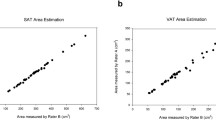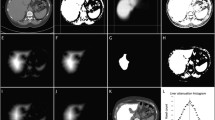Abstract
Metabolic syndrome increases the risk of developing diabetes and cardiovascular disease, particularly heart failure. Abdominal obesity is commonly assessed by measurement of the waist circumference, which exhibits a positive correlation with the visceral fat area measured on computed tomography (CT). CT is an excellent technique for measurement of cross-sectional areas of adipose tissue, but the exposure to ionizing radiation limits broad and repeated application in healthy subjects. Our purpose in this study was to determine the reliability of low-dose CT for abdominal fat quantification as compared with a standard CT protocol. A phantom was scanned by use of changes in the volume of vegetable oil, simulating visceral and subcutaneous adipose tissue, and by changes in the tube current–time products (25–300 mAs). We measured the volume of vegetable oil for each mAs value, and we calculated the minimal detectable change (MDC) in the volume by making repeated measurements. The measured volume of vegetable oil at 50 mAs and higher was not significantly different (p > 0.05), but that at 25 mAs was significantly different (p < 0.001), from that at 300 mAs. The MDC was less than 0.4 ml regardless of the mAs value at all mAs values assessed. We suggest that the adipose tissue volume is determined accurately by CT at 50 mAs (75 % reduction of radiation exposure compared with the standard dose).







Similar content being viewed by others
References
Alberti KG, Zimmet PZ. Definition, diagnosis and classification of diabetes mellitus and its complications. Part 1: diagnosis and classification of diabetes mellitus provisional report of a WHO consultation. Diabet Med. 1998;15:539–53.
Report F. National Cholesterol Education Program. Arch Intern Med. 1991;151:1071.
Alberti KGMM, Zimmet P, Shaw J. Metabolic syndrome–a new world-wide definition. A consensus statement from the International Diabetes Federation. Diabet Med. 2006;23:469–80.
Pouliot MC, Després JP, Lemieux S, Moorjani S, Bouchard C, Tremblay A, et al. Waist circumference and abdominal sagittal diameter: best simple anthropometric indexes of abdominal visceral adipose tissue accumulation and related cardiovascular risk in men and women. Am J Cardiol. 1994;73:460–8.
Kobayashi J, Tadokoro N, Watanabe M, Shinomiya M. A novel method of measuring intra-abdominal fat volume using helical computed tomography. Int J Obes Relat Metab Disord. 2002;26:398–402.
Jensen MD, Kanaley JA, Reed JE, Sheedy PF. Measurement of abdominal and visceral fat with computed tomography and dual-energy X-ray absorptiometry. Am J Clin Nutr. 1995;61:274–8.
Nemoto M, Yeernuer T, Masutani Y, Nomura Y, Hanaoka S, Miki S, et al. Development of automatic visceral fat volume calculation software for CT volume data. J. Obes. 2014;2014:495084.
Yoon DY, Moon JH, Kim HK, Choi CS, Chang SK, Yun EJ, et al. Comparison of low-dose CT and MR for measurement of intra-abdominal adipose tissue: a phantom and human study. Acad Radiol. 2008;15:62–70.
Rogalla P, Meiri N, Hoksch B, Boeing H, Hamm B. Low-dose spiral computed tomography for measuring abdominal fat volume and distribution in a clinical setting. Eur J Clin Nutr. 1998;52:597–602.
Nam SY, Choi IJ, Ryu KH, Park BJ, Kim HB, Nam B-H. Abdominal visceral adipose tissue volume is associated with increased risk of erosive esophagitis in men and women. Gastroenterology. 2010;139(1902–11):e2.
O’Leary DP, O’Neill D, McLaughlin P, O’Neill S, Myers E, Maher MM, et al. Effects of abdominal fat distribution parameters on severity of acute pancreatitis. World J Surg. 2012;36:1679–85.
Rosenquist KJ, Pedley A, Massaro JM, Therkelsen KE, Murabito JM, Hoffmann U, et al. Visceral and subcutaneous fat quality and cardiometabolic risk. JACC Cardiovasc Imaging. 2013;6:762–71.
Donoghue D, Stokes EK. How much change is true change? The minimum detectable change of the Berg Balance Scale in elderly people. J Rehabil Med. 2009;41:343–6.
Fritz SL, Blanton S, Uswatte G, Taub E, Wolf SL. Minimal detectable change scores for the Wolf Motor Function Test. Neurorehabil Neural Repair. 2009;23:662–7.
Steffen T, Seney M. Test-retest reliability and minimal detectable change on balance and ambulation tests, the 36-item short-form health survey, and the unified Parkinson disease rating scale in people with parkinsonism. Phys Ther. 2008;88:733–46.
Haley SM, Fragala-Pinkham MA. Interpreting change scores of tests and measures used in physical therapy. Phys Ther. 2006;86:735–43.
Sjöström L, Kvist H, Cederblad A, Tylén U. Determination of total adipose tissue and body fat in women by computed tomography, 40 K, and tritium. Am J Physiol. 1986;250:E736–45.
Brandberg J, Lonn L, Bergelin E, Sjostrom L, Forssell-Aronsson E, Starck G. Accurate tissue area measurements with considerably reduced radiation dose achieved by patient-specific CT scan parameters. Br J Radiol. 2008;81:801–8.
Dicker D, Herskovitz P, Katz M, Atar E, Bachar GN. Computed tomography study of the effect of orlistat on visceral adipose tissue volume in obese subjects. Isr. Med. Assoc. J. 2010;12:199–202.
Martin Bland J, Altman D. Statistical methods for assessing agreement between two methods of clinical measurement. Lancet. 1986;327:307–10.
DE Beaton. Understanding the Relevance of Measured Change Through Studies of Responsiveness. Spine (Phila. Pa. 1976). 2000;25:3192–9.
Conflict of interest
The authors declare that they have no conflict of interest.
Author information
Authors and Affiliations
Corresponding author
About this article
Cite this article
Onuma, T., Kamishima, T., Sasaki, T. et al. Absolute reliability of adipose tissue volume measurement by computed tomography: application of low-dose scan and minimal detectable change—a phantom study. Radiol Phys Technol 8, 312–319 (2015). https://doi.org/10.1007/s12194-015-0322-5
Received:
Revised:
Accepted:
Published:
Issue Date:
DOI: https://doi.org/10.1007/s12194-015-0322-5




